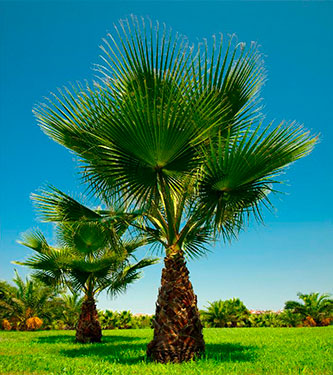Washingtonia filifera, also known as desert fan palm or California fan palm or California palm, is a flowering plant in the palm family (Arecaceae), and native to the southwestern U.S. and Baja California. Growing to 15–20 m (49–66 ft) tall by 3–6 m (10–20 ft) broad, it is an evergreen monocot with a tree-like growth habit. It has a sturdy columnar trunk and waxy fan-shaped (palmate) leaves.
Other common names include California fan palm and petticoat palm. The specific epithet filifera means "thread-bearing".
Washingtonia filifera is the only palm native to the Western United States and the country's largest native palm.
Primary populations are found in desert riparian habitats at spring-fed and stream-fed oases in the Colorado Desert and at a few scattered locations in the Mojave Desert. It is also found near watercourses in the Sonoran Desert along the Gila River in Yuma,[12] along the Hassayampa River and near New River in Maricopa County, and in portions of Pima County, Pinal County, Mohave County (along the Colorado River) and several other isolated locations in Clark County, Nevada. It is a naturalized species in the warm springs near Death Valley and in the extreme northwest of Sonora (Mexico). It is also reportedly naturalized in the Southeast, Florida, Hawaii, the U.S. Virgin Islands, and Australia (New South Wales).
Washingtonia filifera grows to 18 metres (59 ft) in height (occasionally to 25 metres (82 ft)) in ideal conditions. The California Fan Palm Tree is also known as the Desert Fan Palm, American Cotton Palm and Arizona Fan Palm.
The fronds are up to 3.5–4 metres (11–13 ft) long, made up of a petiole up to 2 metres (6.6 ft) long, bearing a fan of leaflets 1.5–2 metres (4.9–6.6 ft) long. They have long thread-like white fibers and the petioles are pure green with yellow edges and filifera-filaments, between the segments. The trunk is gray and tan and the leaves are gray green. When the fronds die they remain attached and drop down to cloak the trunk in a wide skirt. The shelter that the skirt creates provides a microhabitat for many small birds and invertebrates. If there is any red color present on petioles or trunk it is not a pure filifera but a fila-busta hybrid.
Washingtonia filifera can live from 80 to 250 years or more.
Desert fan palms provide habitat for the giant palm boring beetle, western yellow bat, hooded oriole and many other bird species. Hooded orioles rely on the trees for food and places to build nests. Numerous insect species visit the hanging inflorescences that appear in late spring.
